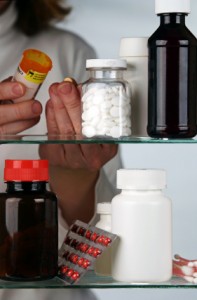 Few preppers would argue that a medicine cabinet checklist is one of the most important components of your emergency-preparedness plan. After a major disaster, you can count on the fact that local pharmacies will suffer the same fate as food and supply stores—empty shelves, looting and few if any remaining, usable perishable items. In fact, they may be first on the list of looters hoping to load up on “marketable” prescription drugs and narcotics. Certainly, those with a need for expensive medicines will also make desperate attempts to add to their stockpiles.
Few preppers would argue that a medicine cabinet checklist is one of the most important components of your emergency-preparedness plan. After a major disaster, you can count on the fact that local pharmacies will suffer the same fate as food and supply stores—empty shelves, looting and few if any remaining, usable perishable items. In fact, they may be first on the list of looters hoping to load up on “marketable” prescription drugs and narcotics. Certainly, those with a need for expensive medicines will also make desperate attempts to add to their stockpiles.
Even in a situation that allowed for a more orderly run on supplies, pharmacies generally only carry about a day’s worth of inventory of prescription medicines. So, if supplier deliveries are cut off for any length of time, and you don’t have a personal relationship with the pharmacist, you’ll likely go home empty handed.
The bottom line is that your preparedness plan should account for the possibility that there will be no access to additional medical supplies. Your objective should be to create a medicine cabinet that can sustain your family for an indeterminate period of time. Since most medicines have an expiration date, the time frame is going to be largely dictated by expiration dates.
Stockpiling medicines is made difficult by regulations, insurance restrictions, and the physician’s own preferences and or ethics. A long term plan and its deliberate execution will increase your chances of meeting your stockpiling objectives.
Follow these steps to complete your emergency medicine cabinet.
The first step is to make sure you have the proper storage set up. Many meds require refrigeration so it will be important to have a dedicated unit. Of course, should you lose power, you’ll have a completely different problem on your hands, which is why you should consider investing in a solar-powered generator if you have chronic medical needs.
The second step is to create an organization system that lets you store meds based on expiration. As you begin to add to your stockpile you will need to rotate medicines on your shelf by their expiration dates.
Third, make a list of all prescription drugs and research their availability in generic brands. As part of the list, you should categorize the meds based on family member, dosage, and by difficulty of obtaining refills. Most doctors and insurance companies won’t allow for stockpiling of certain meds. Your list should include a timetable for contacting your doctor for refills, whether or not you need them. The idea is that, over time, you will acquire more meds than you currently need.
In some cases, depending on your relationship with your doctor, you can get them to write prescriptions for several months ahead of time. You should be able to fill those prescriptions immediately, but keep in mind your expiration time table. You may want to stagger the purchases.
Your fourth step is to make a list of prescription meds that you don’t have but that should be a part of your medicine cabinet. For instance, Tamiflu and antibiotics will be essential during flu season. Be careful with some antibiotics as they can become toxic if held past their expiration. Hydrocodone, codeine and other pain medicines are good to have on hand and prescriptions are fairly easy to obtain. Meds for diarrhea and topical steroid creams are easy to obtain as well. You should try to add to these based on your timetable or as frequently as possible.

Pharmacies generally only carry about a day’s worth of inventory of prescription medicines.
Fifth, organize your OTC supplies. The standards such as cold medicines, antiseptics, fungal creams, Neosporin, rash medicines, aspirin, hydrogen peroxide, eye and ear drops, sodium chloride, etc., should all be in good supply, again, with careful attention to expiration.
Sixth, prepare your medical kit. Find the most well-equipped medical kit and buy three. If it doesn’t contain tools and supplies for more advanced medical procedures such as suturing, you will need to add to it.
Your seventh step is to obtain additional knowledge and skills in emergency medicine. At the very least, you and your family members should complete a standard first-aid course that includes CPR. These are offered through community colleges and local medical associations. It is highly recommended that some family members acquire more advanced training which can be obtained through wilderness first-aid courses such as those offered through the National Outdoor Leadership School.
Eighth, make sure all of your family members’ vaccinations are current. Have a current record of your children’s vaccination schedule on hand and check it periodically. Check with your doctor for recommended adult immunizations.
Ninth, stock up on vitamins and supplements, including drink supplements such as Ensure. These all have expirations as well, so don’t buy them all at once.
Finally, if you haven’t already, put your family on a regimented exercise and nutrition routine that will help everyone reach an optimal health and fitness level. In the end, this is your best method of preventative medicine and can help make you less reliant on the need for meds in the future.
As part of your long-term plan, you should make a point of getting to know your pharmacists. You’ll need to “train” them on your pattern of prescription drugs purchases. And, in the unlikely event that he or she will be around after the TEOTWAWKI, you may be able to get some preferential treatment. Of course, you should never rely upon that. Your emergency medicine cabinet should be able to provide for all of your medical needs.
Other articles in this issue:
If you liked this article you may be interested in this product from our sponsor.

 Off The Grid News Better Ideas For Off The Grid Living
Off The Grid News Better Ideas For Off The Grid Living



